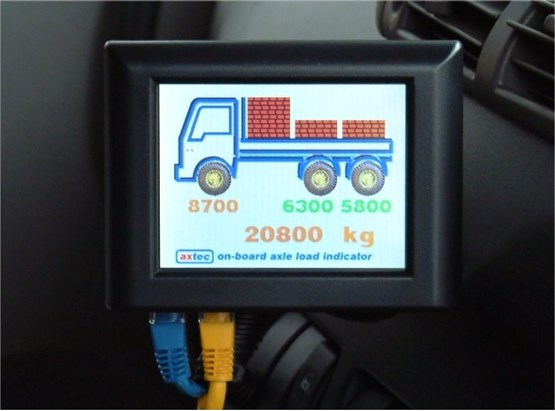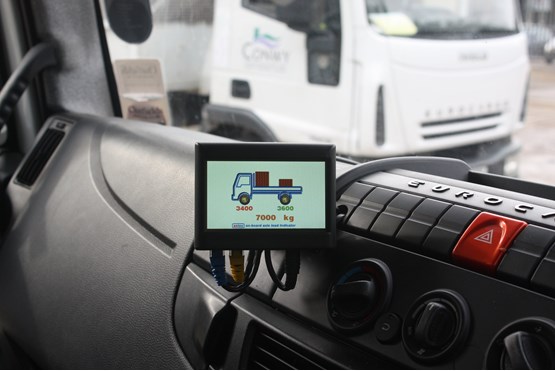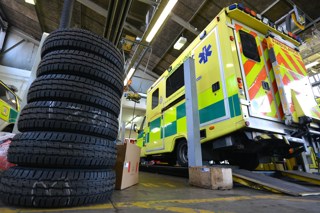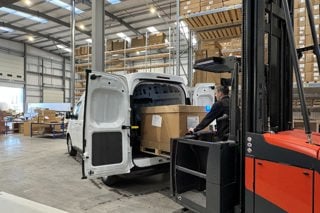Having your own mobile or fixed weighing system may seem expensive but against the possible severity of fines the numbers stack up more positively, John Lewis discovers.
Often tight on payload capacity, 3.5-tonners – and tippers and dropsides, in particular – are especially prone to overloading.
Mount a tipper body on a 3.5-tonne chassis, add a waste cage plus a tail-lift and its legal carrying capacity may be no more than 750kg.
The problem is compounded by the extent to which businesses are using 3.5-tonners on work that used to be the preserve of heavier vehicles, says Red Forge managing director, Andy Freeman.

“They’re trying to avoid the cost and inconvenience of getting somebody trained to drive something bigger and ensuring that they’ve got a Certificate of Professional Competence,” he observes.
Venture above 3.5 tonnes and you are of course into O-licensing, tachograph and Drivers Hours territory; complications which fleets that solely run light vehicles would probably rather avoid.
A company that, as a consequence, elects to remain at 3.5 tonnes should think seriously about having an on-board weighing system fitted.
Red Forge is among the firms that supply and install them, a list that also includes Vehicle Weighing Solutions (VWS) and Axtec.
READ MORE: First company approved in UK to self-verify Pay By Weight systems
“We fit mini load cells that measure suspension deflection,” says Axtec sales manager, Derek Hack.
“On a 3.5-tonner they’re accurate to within plus or minus 2.5% and we install one at the front, and one at the back.
“A colour display in the cab gives you the front axle weight, back axle weight and gross weight,” he continues.
“Get to 80% of the permitted weight and the display glows amber, exceed it and it glows red.”
Audible warnings can also be fitted if the operator wants them.

Connect the weigher to a telematics system and a transport manager in a faraway office can be alerted if there is too much weight on board and take appropriate action.
Details of overloads are also stored in the on-board unit’s memory which the manager can interrogate when the vehicle gets back to depot.
“Bear in mind, though, that if a vehicle is being loaded in a yard somewhere then it could show a front axle overload which disappears as loading continues and you get some weight over the rear axle,” Hack says.
VWS managing director Julian Glasspole says: “We can install a slave display in the back of the vehicle so whoever is loading it can be sure it’s loaded legally.
"That way they don’t have to keep going backwards and forwards to the cab.”
A weighing system can be put in when the vehicle is first built or it can be retrofitted.

“Around 40% of our installations are retrofits and the work required takes around two-and-a-half hours,” Hack says.
As a vehicle gets older, its road springs wear and the on-board weighing system’s calibration can drift. “Software is available so fleet managers can re-set it,” he adds.
VWS recommends an annual recalibration.
So what does an installation on a 3.5-tonner cost? Typically from £1,100 to £1,500, including labour.
“Remember though the maximum fine for an overload on conviction is £5,000 and that you can be fined separately for each axle load and for a gross overload,” Hack says.
“On a 3.5-tonner you could, in theory, be looking at a fine of up to £15,000.”
READ MORE: Ambulance Trust will roll out a new vehicle weight programme
A hefty fine should not come as a surprise given the extent to which overloading can lengthen braking distances and affect a vehicle’s handling.
It also shortens the life of key components, and the life of tyres in particular, and can invalidate your insurance. You burn more fuel, too.
Hack points out that a class of vehicle that is particularly prone to overloading is the six- or eight-seater 3.5-tonne combi with a separate cargo area at the back which is often full of bags of cement, tools and so on.
“One of the difficulties here is that vehicle manufacturers only quote a nominal 75kg for the weight of the driver and each passenger,” he says. “That’s inadequate these days.”
Freeman adds: “Some of the guys in these vehicles are a lot bigger than 75kg.”
In his view some operators now need to face facts as far as weights are concerned and move up from 3.5 tonnes to closer to five tonnes.
Order a 3.5-tonner with a crew cab, a pick-up body and a tail-lift and the limited payload capacity available may render it practically unusable, he claims.
The only way to avoid such an outcome other than switching to a higher weight category is to specify the vehicle very carefully and to look closely at the burden imposed by each and every item fitted.
“One of the biggest issues within this weight category is a lack of front axle capacity,” Freeman sats.

“It means most crew cab 3.5-tonners cannot carry the number of passengers the cab is designed for. Many cannot transport more than two or three people before a front axle overload occurs.
“At Red Forge, we have even seen vehicles that are up to weight on the front axle before any payload has been added,” he says.
There are other ways of checking the legal weight of vehicles, Hack points out.
One option is to use portable weigh pads which transport managers can take to satellite locations if they are concerned that there may an overloading problem.
Another is to install a permanent axle weighbridge if vehicles are regularly in and out of a particular site.
A static axle weighbridge suitable for weighing a light commercial is not as expensive as fleets may suppose.
“You’re talking about £7,500 to £8,000 including ground works and it could last you for 40 years,” Hack says.
“By contrast a set of weigh pads will cost you £6,000 and may only last for five years.”

Weight pads rattling around in someone’s boot, probably dropped every so often then driven over regularly in all weathers does not make for a long life.
A weighbridge should be accurate to within 40kg, whereas with weigh pads the practical accuracy is more like 100kg plus or minus.
Nor are they that easy to use correctly, warns Hack. “You can’t just take them out of the back of your car and dump them on the ground,” he says.
If they are not placed on a level, unyielding surface such as a concrete slab, the readings they give cannot be relied on.
“The other problem is that people often forget to charge them before they take them out to use them,” Hack adds.
READ MORE: Conversions: Weight watching more important than ever
Fleets operating multi-axle heavy trucks with their more-complex suspension systems should consider installing a dynamic axle weighbridge.
More expensive than the static type, they cost around £16,000 to £18,000 including groundworks.
Pay closer attention to how much weight your vehicles are carrying and they are likely to prove more productive.
Fearful of being responsible for an overloading offence, managers may be sending the vehicles out with less cargo on-board than they can legally transport, just to be on the safe side.
Fit an on-board weigher or invest in a weighbridge and companies will be able to make full use of the legal payload without worrying that they’ll end up in trouble with the law.


















Andrew B - 31/01/2018 20:30
As a Police Officer now retired I actively enforced overloaded vehicles. 3500kg vehicle’s are a nightmare thre are three things you can’t do with one. RECOVERY SCAFFOLDING, HOUSE REMOVAL. I once dealt with a firm who had a special vehicle built on a 3500 kg body. It had a pay load of 180kg totally useles.